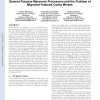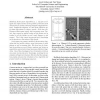608 search results - page 1 / 122 » Some Solutions to the Missing Feature Problem in Vision |
NIPS
1992
15 years 2 months ago
1992
In visual processing the ability to deal with missing and noisy information is crucial. Occlusions and unreliable feature detectors often lead to situations where little or no dir...
130
click to vote
SCIA
2009
Springer
15 years 7 months ago
2009
Springer
Abstract. Solutions to non-linear least squares problems play an essential role in structure and motion problems in computer vision. The predominant approach for solving these prob...
100
click to vote
CF
2010
ACM
15 years 6 months ago
2010
ACM
As the number of transistors on a chip doubles with every technology generation, the number of on-chip cores also increases rapidly, making possible in a foreseeable future to des...
103
click to vote
CVPR
2005
IEEE
16 years 3 months ago
2005
IEEE
The problem of low-rank matrix factorization in the presence of missing data has seen significant attention in recent computer vision research. The approach that dominates the lit...
115
click to vote
CVPR
2004
IEEE
16 years 3 months ago
2004
IEEE
Multibody factorization algorithms [2, 1, 16] give an elegant and simple solution to the problem of structure from motion even for scenes containing multiple independent motions. ...


